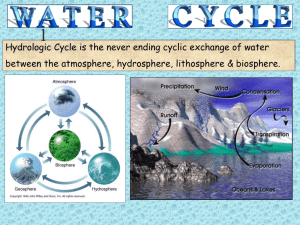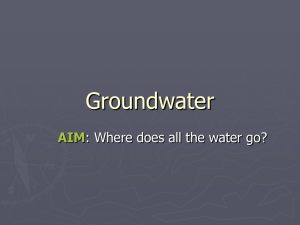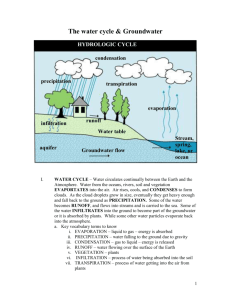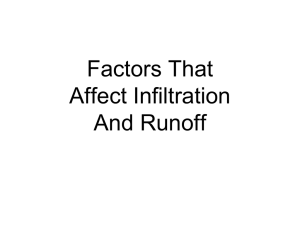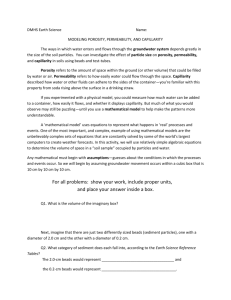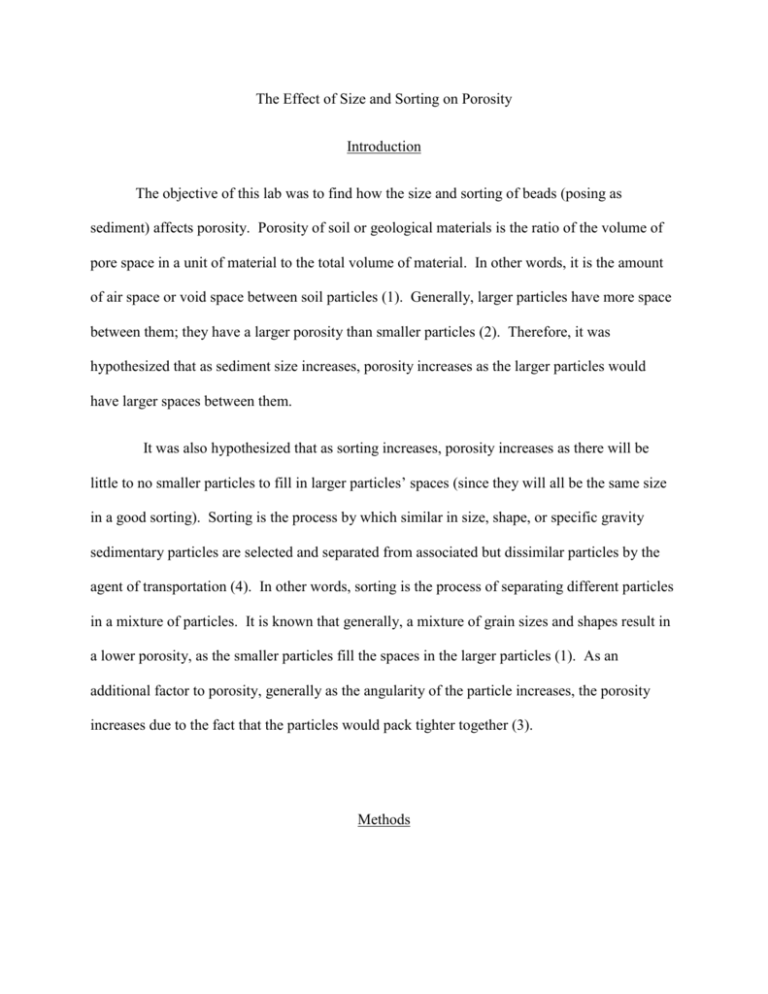
The Effect of Size and Sorting on Porosity
Introduction
The objective of this lab was to find how the size and sorting of beads (posing as
sediment) affects porosity. Porosity of soil or geological materials is the ratio of the volume of
pore space in a unit of material to the total volume of material. In other words, it is the amount
of air space or void space between soil particles (1). Generally, larger particles have more space
between them; they have a larger porosity than smaller particles (2). Therefore, it was
hypothesized that as sediment size increases, porosity increases as the larger particles would
have larger spaces between them.
It was also hypothesized that as sorting increases, porosity increases as there will be
little to no smaller particles to fill in larger particles’ spaces (since they will all be the same size
in a good sorting). Sorting is the process by which similar in size, shape, or specific gravity
sedimentary particles are selected and separated from associated but dissimilar particles by the
agent of transportation (4). In other words, sorting is the process of separating different particles
in a mixture of particles. It is known that generally, a mixture of grain sizes and shapes result in
a lower porosity, as the smaller particles fill the spaces in the larger particles (1). As an
additional factor to porosity, generally as the angularity of the particle increases, the porosity
increases due to the fact that the particles would pack tighter together (3).
Methods
In order for this lab to have been performed small beads, large beads, and 3 graduated
cylinders were needed. Firstly, 30 mL of small beads were poured into a graduated cylinder and
30 mL of large beads were poured into another graduated cylinder. Then, 50 mL of water was
added to each graduated cylinder. Then, the water level was measured on both filled graduated
cylinders and recorded. After, the water was poured out of each (without losing any beads) and
the beads were mixed together by pouring one set of beads into the other set. The graduated
cylinder containing all the beads was then shaken, with a hand over the mouth of the cylinder.
After shaking, the volume of the beads was then measured and recorded. Then, 50 mL of water
was poured into the graduated cylinder with all the beads in it. The water level was then
measured and recorded.
Results
Figure 1:
Figure 1 shows the porosity of small beads, large beads, and poorly sorted beads.
Porosity
40.00%
35.00%
36.67%
36.67%
Porosity (%)
30.00%
29.17%
25.00%
20.00%
15.00%
10.00%
5.00%
0.00%
Small Beads
Large Beads
Poor Sorting
Calculations:
Equation 1:
To find the porosity, the following equation was used.
(Volume of Water Added – (Volume of Water After Adding – Volume of the Beads)) / Volume
of Beads = Porosity
The following is an example of how the equation was used in the lab (finding the porosity
of the small beads).
( 50 mL – ( 69 mL – 30 mL ) ) / 30 mL = about .3667 or 36.67%
Discussion
To calculate porosity, the Equation 1 was used. Equation 1 obtains the percentage of air
space inside the volume of beads by calculating the volume of water in the beads’ spaces and
converting it into a percent. In order to do this the “Volume of Water Added” was first found.
In this experiment, this number was 50 mL since 50 mL of water was added to each graduated
cylinder. Then the volume of water within the volume of beads was taken. This was done by
subtracting “Volume of Beads” (30 mL for the well sorted beads and 60 mL for the poorly sorted
beads) from the “Volume of Water After Adding” (69 mL for the well sorted beads and 92.5 mL
for the poorly sorted beads). Then this amount (39 mL for the well sorted, 17.5 mL for the
poorly sorted) was subtracted from the “Volume of Water Added” (50 mL) to get the volume of
water within the volume of beads. This was done because the volume of water within the
volume of beads was needed, not the entire volume of water which would include the volume of
water above the beads. Since Porosity is the percent of air space in a volume of particles, the
volume of water in the particles was divided by the “Volume of Beads” (30 mL for the well
sorted, 60 mL for the poorly sorted) (1). This number was then converted into a percent by
multiplying by 10 and putting a percent sign (%) after it (36.67% for the well sorted beads,
29.17% for the poorly sorted beads).
Based on the data shown in Figure 1, the first hypothesis was not supported. In Figure 1,
it can be seen that the porosity of the small beads (36.67%) is the same as the porosity of the
large beads (36.67%). This data suggests that as size of particle increases, porosity stays the
same. However, as stated before, larger particles have more space between them and, in turn,
have a greater porosity than smaller particles (2). One important factor to consider in this
statement is the shape of the particle. In the source, it references large rocks to small pebbles
instead of the perfect spheres used in the lab. Rocks and pebbles rarely form in perfect spheres
and, in turn, while the statement works for non-uniform shaped particles, it clearly does not work
for uniform shaped particles. This conclusion is further proven by the fact that the diameter size
of the particles does not affect porosity if uniform. For instance, basketballs and Ping-Pong
balls, which are both spheres, if compacted uniformly have the exact same porosity (1).
Another factor to take into consideration is the size difference between particles. In the
example given by source 2, the author compares large rocks to tiny pebbles. The size difference
between these two particles is huge compared to the difference between the small beads and
large beads. This may have been another factor that caused the same porosity of small and large
beads shown in Figure 1. In turn, an improvement to the lab could be using drastically different
sized beads. However, size of a particle is not the only factor when considering porosity.
The packing of the particles is another huge factor to consider with porosity. Even if the
particles are the same size, if the arrangement or packing of particles can change the porosity. If
the particles are directly on top of each other, a type of arrangement called cubic packing, there
is generally a higher porosity than rhombohedral packing. Rhombohedral packing is when the
particles are stacked in a triangular shape so that each single particle is on top of two other
particles (which are horizontally touching) (1). Since the experiment did not take this into
account, it is possible that a difference between large and small beads’ porosities could have
been observed, depending on how the beads landed in the graduated cylinder. The small beads
could have been under rhombohedral packing and, in turn, have a smaller porosity than what
should have been observed in they were under cubic packing. To improve the experiment, there
must be some sort of way to ensure that both beads have the same packing technique. One
possible solution would be to get a smaller graduated cylinder which is just large enough to have
precise cubic packing for each bead type. Although not apparent in this set of data, the packing
type is still a factor which should be controlled in the experiment. Therefore, assuming packing
is the same, if all particles are spheres, as size increases porosity remains the same.
Figure 1 supports the second hypothesis; as sorting increases, porosity increases. The
data shown in Figure 1 supports this hypothesis; as sorting increases, so does porosity. There is
a clear difference between the poorly sorted beads (29.17%) and the well sorted large and small
beads (36.67%). This makes sense because, generally, a mixture of grain sizes and shapes result
in a lower porosity, as the smaller particles fill the spaces in the larger particles (1). However,
the experiment only used two sizes of same shaped particles in this experiment.
In sediment, there is rarely a case in which there are only two same shaped particles that
form an entire layer. There are often multiple sizes and shapes involved in creating sediment.
Both size and shape are huge factors that must be taken into account when considering porosity
(1). In order to improve the experiment, different mixtures of multiple different sized particles
must be used. Again, drastic size differences and different shapes should be used since these
properties occur in nature. In order to have accurate representations of porosity in the
experiment different shaped, such as cubes, and drastically different sized particles should be
used in future experiments. However, this change would only create a greater porosity
difference; the data shown seems relatively accurate as the mixed same shaped, different sized
particles have a lower porosity than the well sorted particles. The packing of the particles may
then be different when the graduated cylinder was shaken since the even smaller particles could
have fit into the large particles’ spaces even more than the small beads used in the experiment. If
this were to happen, then the porosity would have been even lower than the result found in this
experiment. However, this would not change the fact that the porosity of the poorly sorted
particles was lower than the sorted particles. Therefore, based on the data, it can still be
concluded that, for same shaped slightly different sized particles, as sorting increases, porosity
increases.
Some factors that could have influenced the outcome of the experiment include the
estimation of beads and loss of water when attempting to pour it into the graduated cylinder.
Due to the fact that it is almost impossible to get exactly 30 mL of beads, since they do not stack
perfectly, the actual volume compared to the estimated volume may be off. If the estimated
volume of the beads is 30 mL but is actually 31 mL, the water level after adding water would be
higher and vice versa. Because of this, the porosity calculation may be slightly higher, if the
beads were lower than estimated, or lower, if the beads were higher than estimated. Although
the difference may seem miniscule with only a 1 mL change in water level, if the experiment is
not done carefully enough there could be as much as a 3 mL difference resulting in an extremely
off porosity calculation. Therefore, although not entirely avoidable, the volume of the beads
must be carefully measured to 30 mL for accurate results. The graduated cylinder must be
shaken lightly to ensure that the beads are at exactly 30 mL.
Another factor to take into consideration is the accidental loss of water before or during
the pour into the graduated cylinder. If as much as 1 mL of water is spilled out of the graduated
cylinder but still taken as “50 mL”, the water level will drop by 1 mL. In turn, similar to the
effect of badly estimated bead volume, the porosity will increase. The calculations will be
inaccurate as the measurements will be off. If the water added is still taken as 50 mL when it is
actually 49 mL, the porosity will increase. If the experimenter is not careful and more than 1 mL
is spilled, the porosity will be even higher than the actual. Although neither of the factors
mentioned impacted the outcome of the well sorted beads’ porosities since they are the same,
loss of water may have impacted the outcome of the poorly sorted beads’ porosity. If water was
lost before or during pouring it into the graduated cylinder, for the poorly sorted beads, the
porosity may have risen. However, as stated before, the porosity is still relatively accurate since
it is still less than the well sorted beads’ porosity. The loss of beads would have been evident
when measuring the volume of the beads again after mixing, so it was not a factor that affected
the outcome of the lab. Therefore, the data can still be considered accurate, and the conclusions
reached based on the data can still be considered accurate.
Porosity is often associated with permeability; the measure of how well a liquid can pass
through a given material (5). Low porosity often results in low permeability since there is less
air space that liquid can pass through. However, high porosity does not always mean a high
permeability. Permeability measures the degree to which the pore spaces are connected and the
size of the connections (6). In order for different levels of permeability, there are many factors
to take into account besides porosity.
Interconnectivity plays a huge part in permeability because it impacts the extent to which
a liquid can go through a material. The force of molecular attraction, a factor when considering
permeability, says that a thin layer of liquid will always be attracted to particles due to the
unsatisfied ionic charge on the surface. If the size of the interconnections is smaller than the
zone of molecular attraction then the liquid is unable to move between pores (6). In other words,
if the pores are not connected or barely connected to the extent of which liquid cannot pass
between them, the material is barely, if at all, permeable. If the particles within a material are
extremely small, this effect will take place since the connections between particles will be
smaller than the zone of molecular attraction; the water will stay stuck to the particle. Therefore,
it can be concluded that as particle size increases permeability increases and vice versa.
However, as stated before, particle sizes and shapes are not completely uniform in nature, thus
there will be some pores and interconnections that are larger than others since the particles will
not stack evenly. Therefore, depending on the shape, permeability will either increases or
decrease. As an example, when considering the effect of size and shape, clay has a low
permeability due to small grain sizes and flat particle shapes. The flat shape results in larger
surface area, leading to increased friction. The increased friction leads to less permeability
because the liquid has a harder time passing through the material (1). Both size and shape are
huge factors when considering permeability since these factors influence interconnectivity, a key
factor when considering permeability.
Expanding on factors that affect interconnectivity, sorting also plays a huge role in
permeability. As established earlier, when sorting increases porosity increases, and, in turn, vice
versa (as shown in Figure 1 with decreased sorting). If the smaller particles fill in the larger
particles, the liquid has less ability to move through the material. The size of interconnection,
when there is poor sorting is less than good sorting since the pores themselves are smaller. Since
there is less porosity in poorer sorted materials, the permeability decreases since the liquid has
more trouble passing through. Therefore it can be concluded that as sorting decreases
permeability decreases. However, it cannot be concluded that as sorting increases permeability
increases. This is due to the fact that as sorting increases porosity increases, but as porosity
increases permeability does not necessarily increase. For example, an igneous rock with many
gas bubbles in it from quick cooling is considered highly porous. However, since the pockets are
not connected, the liquid cannot get through the material and, in turn, the material has a low
permeability (6).
In order to fully understand how groundwater will flow into a sample of sediment, both
porosity and permeability must be taken into account. Permeability measures how well a liquid
can move through a material. In this case, permeability will show how well groundwater can
flow through a sample of sediment. If the sediment is highly permeable, the groundwater can
easily flow through it. If the sediment is barely permeable, if at all, the groundwater will take a
long time to flow through it, or if impermeable the groundwater will not be able to flow through
the sediment.
Although the fact that high porosity does not necessarily mean a higher permeability in
an igneous rock, when considering other types of rocks generally, it is known that as porosity
increases permeability increases (1). Therefore, when considering permeability, porosity
contributes greatly to how groundwater will flow into a sample of sediment. An extremely
porous sediment sample allows for groundwater to easily pass through it and it is therefore
highly permeable. As concluded before, sediment sample with low porosity will have a lower
permeability since there is less space for the groundwater to pass through. As a factor of
porosity, the size of sediment, considering the particles are not uniform, plays a huge part in
permeability.
In order to test for the specific effect that sediment size has on permeability, differently
sized and shaped particles must be used. Since, in nature, there are differently shaped particles
within a given material, the differently shaped particles must be used. To test specifically for
particle size effect on permeability, a few groups of different shaped particles with at least two
sizes must be used. Since sorting plays a huge factor in porosity and, in turn (for sediment),
permeability, the two sizes must be separated and put into separate containers of small and large
particles. Since permeability is the measure of ability of liquid to go through a given material, a
time interval must be established. If the particles together have a low permeability, it will take
more time for the liquid to go through and, in turn, there will be less liquid in the container
meant to catch the liquid. In the experiment, after an interval of time, the liquid collected after
passing through the particles will be measured (there will be a constant supply of liquid on top).
The size with more liquid will clearly be more permeable since the liquid came through the
particles faster.
In the lab, when measuring the porosity of the small beads, it was expected that the small
beads would have a lower porosity than the larger beads. However, this was not the case; the
small beads had the same porosity as the large beads. The differed outcome was intriguing, and,
in turn, more research was done to find out why the porosity did not change between sizes. It was
found that, with perfect spheres, porosity does not differ. This fact led to a new understanding of
the experiment and, in turn, to realizations of how the experiment could be improved using
different shapes. Without data contradicting the hypothesis, this further understanding would not
have been reached; less would be known about porosity and its factors. With an incorrect
hypothesis, more research was done to find out whether there was a calculation error or a flaw in
the prediction, leading to more knowledge of the subject. In the real world, scientists also learn
from wrong hypotheses; they are intrigued which leads to further experiments and, eventually,
further understanding. Advancements in the science world are dependent on incorrect
hypotheses, which lead to or are proved wrong by more experiments. In science, it must be
considered that wrong hypotheses are not detrimental; instead they are more beneficial to a
scientist’s success. It must be considered that if there were no wrong hypotheses, science would
not evolve and, in turn, there would be very little understanding of neither nature, nor the world,
nor the universe.
Appendix
Type
Volume of Beads
Volume After Water
Porosity
Small Beads
30 mL
69 mL
36.67%
Large Beads
30 mL
69 mL
36.67%
Poor Sorting
60 mL
92.5 mL
29.17%
References
1. "Soil Properties That Affect Groundwater." Portage County, WI. Portage County
Government, 2008. Web. 19 Mar. 2012.
<http://www.co.portage.wi.us/groundwater/undrstnd/soil.htm>.
2. "How Does Particle Size Affect Porosity? | GreenAnswers." Green Answers to
Environmental Questions, Recycling, Nature, Animals & More! Green Answers, 2012.
Web. 19 Mar. 2012. <http://greenanswers.com/q/97976/sciencetechnology/chemistry/how-does-particle-size-affect-porosity>
3. "Geology." Enotes.com. Enotes.com. Web. 19 Mar. 2012.
<http://www.enotes.com/geology/q-and-a/how-shape-grain-rock-affect-porosity-95301>.
4. "Sorting." Answers.com. Answers, 2012. Web. 19 Mar. 2012.
<http://www.answers.com/topic/sorting-2>.
5. Tarbuck, Edward J., and Frederick K. Lutgens. Prentice Hall Earth Science. Boston, MA:
Pearson Prentice Hall, 2009. Print.
6. Nelson, Stephen A. "Groundwater." Tulane University. Tulane University, 3 Apr. 2011.
Web. 19 Mar. 2012. <http://www.tulane.edu/~sanelson/geol111/groundwater.htm>.




